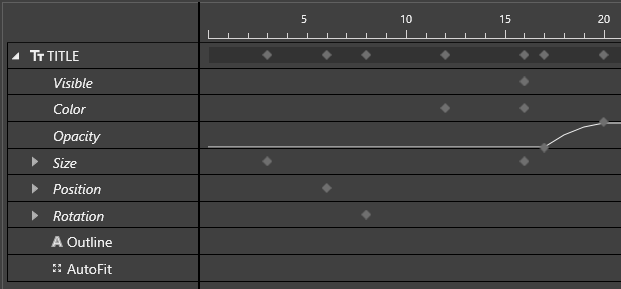Understanding the Timeline
Reading time ~4 minutes
The timeline is used to control the scene objects over time.

The top-right part of the timeline shows the current editing range of the objects display.
Below the time ruler each object of the scene is represented as a separate track with the possibility to change its starting time and/or duration, add keyframes to create animated effects.
Timeline Panels
The timeline consists of four main panels:

On top there is the ruler that allows you to browse through the frames.
The left center panel displays the object currently selected in the tree. The details displayed in this area change as the selection changes. It is possible to define the detail level for the scene objects to be displayed on the timeline. If the "Show all parameters" option from the "Edit" main menu is selected, all parameters of the selected object will be displayed. If this option is deselected, only animated parameters (that have any keyframes defined) of the object are displayed. To display all objects added to the CG scene on the timeline, enable the "Show all objects" option from the "Edit" main menu. If this option is not selected, only the object selected in the tree and its nested objects will be displayed in the objects panel of the timeline.
In the center panel, you can see objects (or their parameters) as layers in a classic timeline form, where it is possible to interact with and alter their start time and/or duration.
The time scale control is located on the bottommost panel. It allows you to change the time scale on the timeline and scroll to its desired position. Also, you can scroll the mouse wheel while holding the Ctrl key pressed to zoom in/out on timeline. Alternatively, use the Ctrl+Gray+ or Ctrl+Gray- shortcuts respectively.
Moving the Current Frame Position
There are several ways to move to the desired frame position:
-
Click on the desired location on the timeline to jump to that location.
-
Left-click the animation position slider and holding it move the slider to the desired timeline location.
-
Hit Space to start/stop playing.
-
Use the Ctrl+→ or Ctrl+← shortcuts to jump the animation position slider to the next or previous keyframe respectively.
There is the "Snap to objects" option for the timeline slider. While moving the slider to the desired timeline location, it will snap to the nearest keyframe or the start/end of the object track. This option can be selected in the "Edit" main menu.
Working with the Objects on the Timeline
Changing the Duration
To change the object track duration, place the mouse cursor over the start or the end of the track. The cursor will change its icon accordingly:

Press the left mouse button and drag it to the desired position. The track duration will change accordingly.
Repositioning
You can also change the temporal position of the object by dragging it to the desired position on the timeline. To do this, click on the object track and drag it to the required position. The cursor icon changes to the double sided arrow while dragging.

Grouping
For every object that has keyframe(s) set up, the corresponding track for every animated property is displayed on the timeline.
Also, a separate track is displayed for every effect added to an object.

The objects can be organized using the group object in the "Layers" tab. On the timeline group objects are displayed in dark grey. Objects grouped inside each other have start and end markers on the parent object’s track on the timeline.
|
Note
|
The duration of the group object on the timeline sets bounds to displaying of all the objects enclosed in that group. The enclosed objects can have longer duration than the group object duration. In this case the portion of the objects after the end of the group object track will not be displayed on the canvas. |
Group track displays all the keyframes of its nested objects. The topmost track on the timeline displays all the keyframes set up on all the tracks of the scene:
